Toyota Grand Highlander (AS10) 2024 Owners Manual / Driving / Driving procedures / Automatic transmission
Toyota Grand Highlander (AS10): Automatic transmission
Select the shift position depending on your purpose and situation.
Shift position purpose
P - Parking the vehicle/
starting the engine
R - Reversing
N - Neutral
D - Normal driving*1
M - M mode driving*2
*1:Shifting to the D position allows the system to select a gear suitable for the driving conditions.
Setting the shift lever to the D position is recommended for normal driving.
*2:Selecting gears using M mode fixes the gear step, controls engine braking force, and prevents unnecessary upshifting.
■To protect the automatic transmission
If the automatic transmission fluid temperature is high, "Transmission Oil Temp High Stop in a Safe Place and See Owner's Manual" will be displayed on the multi-information display and the vehicle will go into transmission protection mode automatically.
Have the vehicle inspected by your Toyota dealer.
■When driving with dynamic radar cruise control activated
Even when performing the following actions with the intent of enabling engine braking, engine braking will not be activated because dynamic radar cruise control will not be canceled.
- Vehicles with paddle shift switches: While driving in the D position, downshifting to D5 or D4.
- When switching the driving mode to sport mode while driving in the D position.
■AI-SHIFT
The AI-SHIFT automatically selects the suitable gear according to driver performance and driving conditions.
The AI-SHIFT automatically operates when the shift lever is in D.
(Shifting the shift lever to the M position cancels the function.)
WARNING
■When driving on slippery road surfaces
Be careful of downshifting and sudden acceleration, as this could result in the vehicle skidding to the side or spinning.
Shifting the shift lever
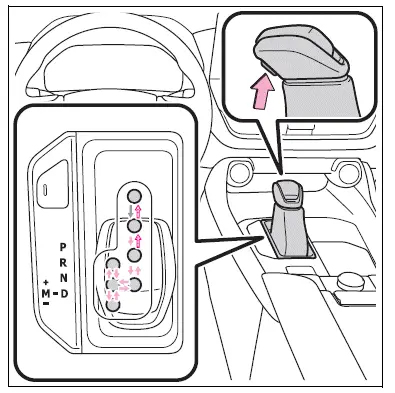
 : While the engine switch is in
ON and the brake pedal
depressed*, shift the shift lever
while pushing the shift release
button on the shift knob.
: While the engine switch is in
ON and the brake pedal
depressed*, shift the shift lever
while pushing the shift release
button on the shift knob.
 : Shift the shift lever while
pushing the shift release button
on the shift knob.
: Shift the shift lever while
pushing the shift release button
on the shift knob.
 : Shift the shift lever
normally.
: Shift the shift lever
normally.
When shifting the shift lever between P and D, make sure that the vehicle is completely stopped.
*: For the vehicle to be able to be shifted from P, the brake pedal must be depressed before the shift release button is pushed. If the shift release button is pushed first, the shift lock will not be released.
■Shift lock system
The shift lock system is a system to prevent accidental operation of the shift lever in starting.
The shift lever can be shifted from P only when the engine switch is in ON and the brake pedal is being depressed.
■If the shift lever cannot be shifted from P
First, check whether the brake pedal is being depressed.
If the shift lever cannot be shifted with your foot on the brake pedal, there may be a problem with the shift lock system. Have the vehicle inspected by your Toyota dealer immediately.
The following steps may be used as an emergency measure to ensure that the shift lever can be shifted.
Releasing the shift lock:
1. Turn the engine switch to ON and check that the parking brake is set.
2. Turn the engine switch to off.
3. Depress the brake pedal.
4. Pry the cover up with a flathead screwdriver or equivalent tool.
To prevent damage to the cover, cover the tip of the screwdriver with a rag.
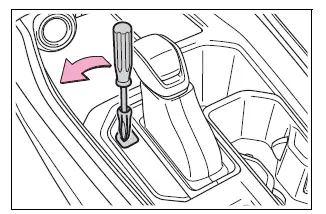
5. Press and hold the shift lock override button.
The shift lever can be shifted while both buttons are pressed.
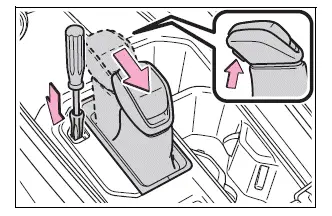
WARNING
■To prevent an accident when releasing the shift lock
Before pressing the shift lock override button, make sure to set the parking brake and depress the brake pedal.
If the accelerator pedal is accidentally depressed instead of the brake pedal when the shift lock override button is pressed and the shift lever is shifted out of P, the vehicle may suddenly start, possibly leading to an accident resulting in death or serious injury.
Selecting shift ranges in the D position (vehicles with paddle shift switches)
To drive using temporary shift range selection, operate the "-" or "+" paddle shift switch.
When the "-" paddle shift switch is operated, the shift range switches to a range that enables engine braking force that is suitable to driving conditions. When the "+" paddle shift switch is operated, the shift range switches to a range that is one range higher than the current range.
Changing the shift range allows restriction of the highest gear, preventing unnecessary upshifting and enabling the level of engine braking force to be selected.
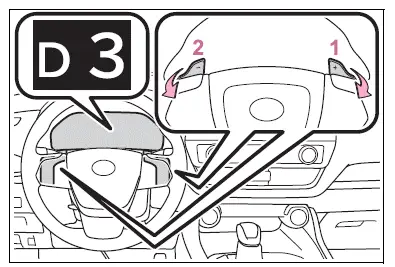
- Upshifting
- Downshifting
The selected shift range, from D1 to D8, will be displayed on the meter.
To return to normal D position driving, the "+" paddle shift switch must be held down for a period of time.
■ Shift ranges and their functions
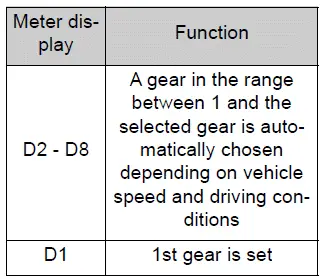
A lower shift range will provide greater engine braking forces than a higher shift range.
■Automatic deactivation of shift range selection in the D position
Shift range selection in the D position will be deactivated in the following situations:
- When the vehicle comes to a stop
- If the accelerator pedal is depressed for more than a certain period of time
- When the shift position is shifted to a position other than D.
■Downshifting restriction warning buzzer
To help ensure safety and driving performance, downshifting operation may sometimes be restricted. In some circumstances, downshifting may not be possible even when the paddle shift switch is operated. (A buzzer will sound twice.)
Selecting gears in the M position
To enter M mode, shift the shift lever to M. Gears can then be selected by operating the shift lever or paddle shift switches*, allowing you to drive in the gear of your choosing.
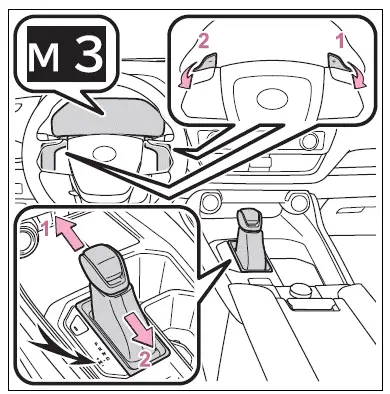
- Upshifting
- Downshifting
The gear changes once every time the shift lever or a paddle shift switch is operated.
The selected gear, from M1 to M8, will be fixed and displayed on the meters.
When in the M position, the gear will not change unless the shift lever or a paddle shift switch is operated.
However, even when in the M position, the gears will be automatically changed in the following situation:
- When vehicle speed drops (downshift only).
- When it is necessary to protect the transmission when the transmission fluid temperature is high or low, or other reasons.
- When the needle of the tachometer is in the red zone (the range which exceeds the allowable revs of the engine).
In the following situation, the gear will not shift even if the shift lever is operated.
- The vehicle speed is low (upshift only).
■Downshifting restriction warning buzzer
To help ensure safety and driving performance, downshifting operation may sometimes be restricted.
(A buzzer will sound twice.)
Similar pages:
Parking Support Brake function
(static objects front and rear of
the vehicle)
If the sensors detect a static
object, such as a wall, in the
traveling direction of the
vehicle and the system
determines that a collision
may occur due to the vehicle
suddenly moving forward
due to an accidental
accelerator pedal operation,
the vehicle moving the
unintended direction due to
the wr ...
Head-up display
The head-up display projects
a variety of driving-
related information and
the operating state of the
driving support systems on
the windshield.
System components
Can be changed the head-up
display type.
The content displayed will differ
according to the driving conditions
and display mode of the
...


